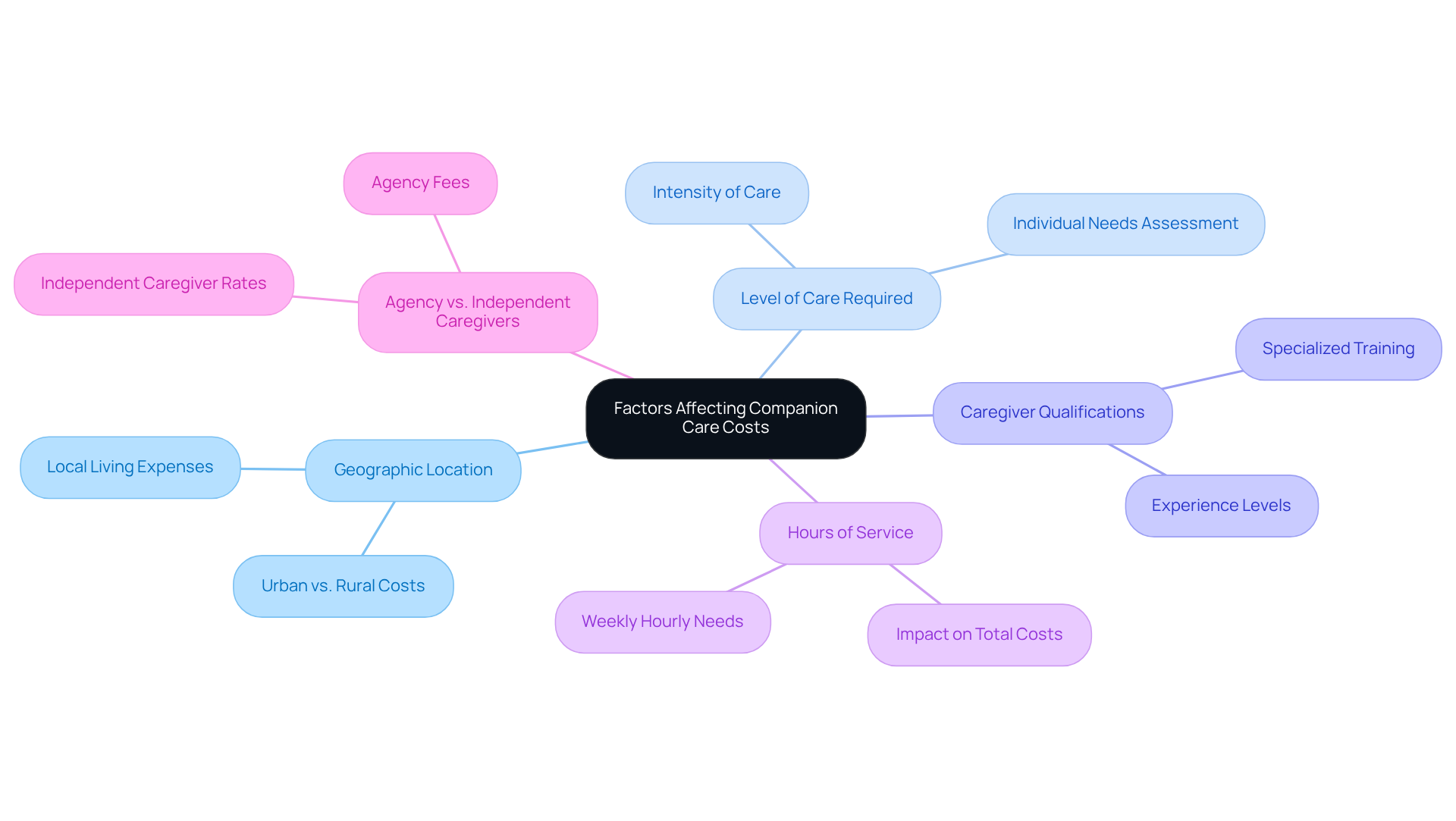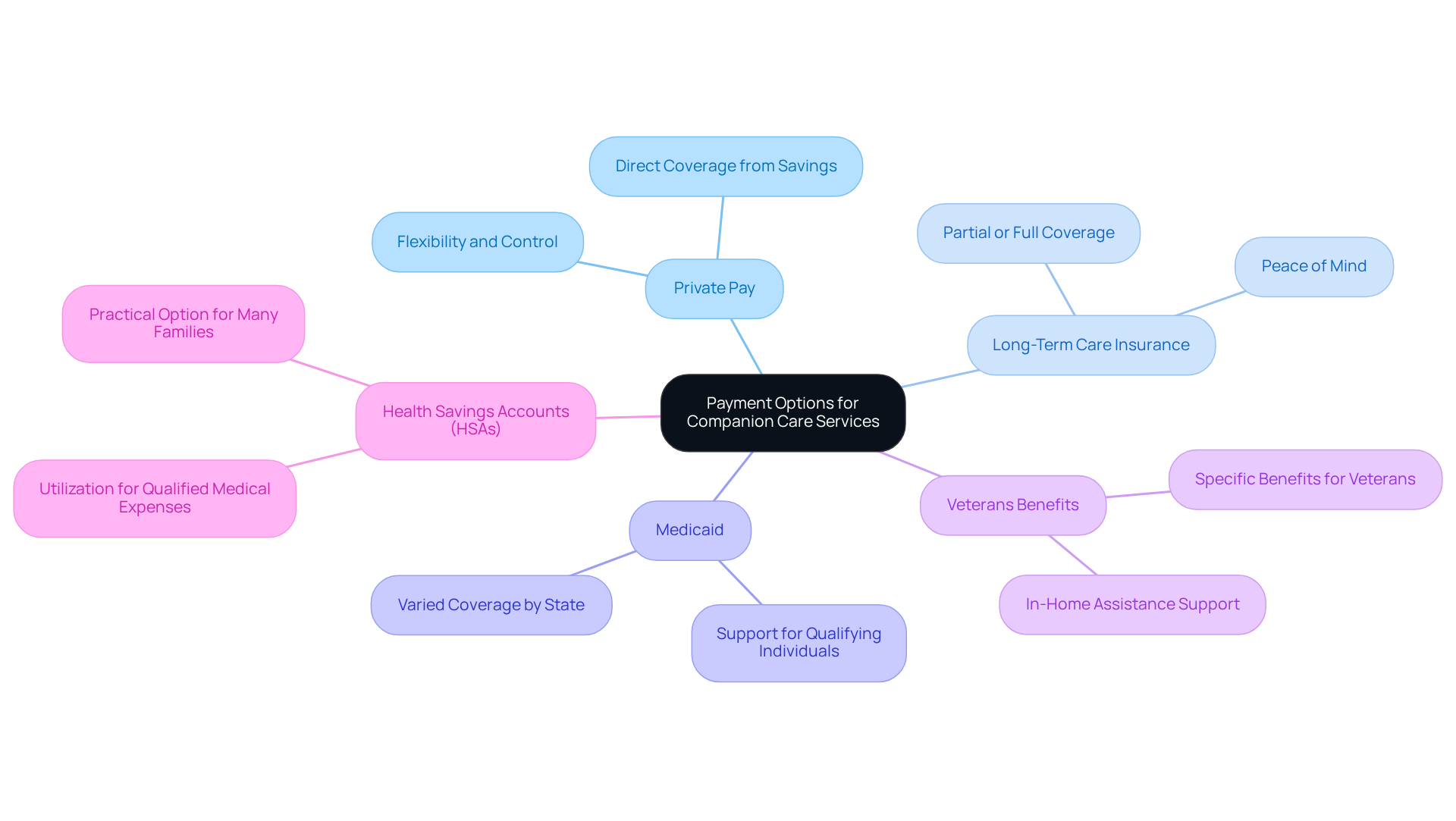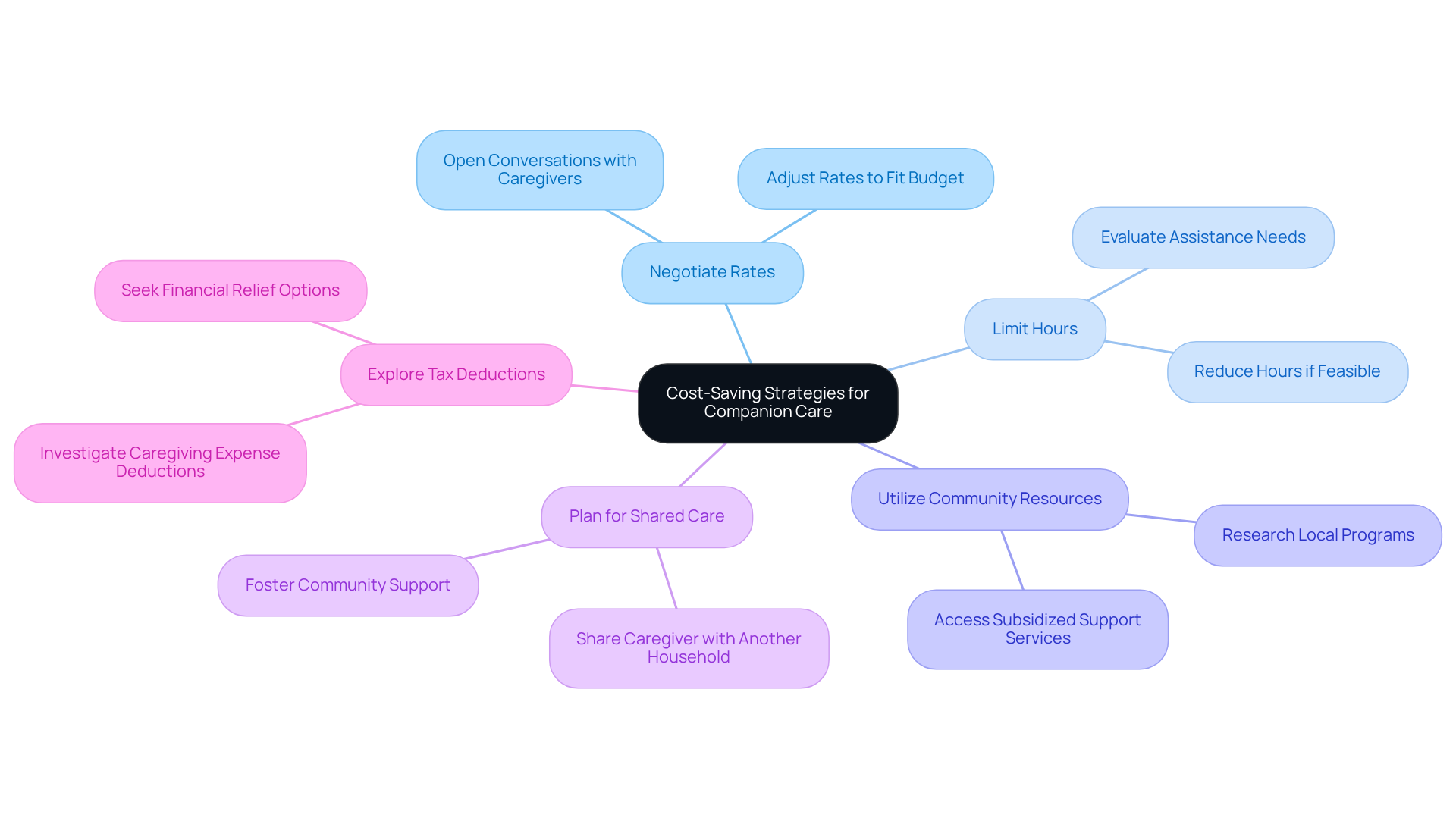Overview
Navigating the cost of companion care can be overwhelming for families. It’s influenced by several key factors, such as:
- Where you live
- The level of care needed
- The qualifications of caregivers
- The hours of service
- Whether caregivers are hired through an agency or work independently
Understanding these factors is essential, especially when you’re trying to ensure your loved ones receive the support they deserve. It’s natural to feel stressed about expenses, but there are various payment options and cost-saving strategies available. These can help ease the financial burden while ensuring that your family member gets the compassionate care they need.
Remember, you’re not alone in this journey. Many families face similar challenges, and there are resources and support systems in place to help you manage these costs effectively. By exploring these options, you can find a solution that works for your situation, allowing you to focus on what truly matters—your loved one’s well-being.
Introduction
Navigating the complexities of companion care can feel overwhelming, especially when you think about the emotional and financial implications for families. It’s not just about providing essential support and companionship for seniors and individuals with disabilities; it’s also about addressing the growing concern of loneliness and isolation that many face. As families strive to ensure the best possible care for their loved ones, understanding the various factors that influence companion care costs becomes crucial.
What strategies can families employ to manage these expenses while still offering the compassionate support their loved ones truly deserve? It’s a question that weighs heavily on many hearts, and finding the right balance can be challenging. But remember, you’re not alone in this journey.
Define Companion Care and Its Importance
Companion assistance is more than just a service; it’s a heartfelt commitment to providing emotional support and companionship for seniors and individuals with disabilities. Many older adults often grapple with feelings of loneliness and isolation, and this support is crucial in alleviating those burdens.
Imagine having someone to share meaningful conversations with, to accompany you on outings, or to lend a hand with light household tasks. Companion caregivers do just that, enhancing the overall quality of life for their clients. They create connections that matter, fostering a sense of belonging and community.
The beauty of supportive assistance lies in its ability to nurture a sense of safety and independence. Clients can maintain their autonomy while receiving the help they need, all within the comfort of their own homes. It’s about creating a warm environment where they feel valued and understood.
In the words of one caregiver, “Every moment spent with my clients is a chance to brighten their day and remind them they’re not alone.” This sentiment captures the essence of companion assistance — it’s about being there, truly being present.
So, if you or a loved one are feeling the weight of loneliness, remember that compassionate support is just a call away. You deserve to feel connected and cared for.
Explore Factors Affecting Companion Care Costs
When it comes to the cost of companion care services, many families find themselves navigating a complex landscape of expenses. It’s completely understandable to feel overwhelmed by the financial aspects, especially when you’re trying to ensure the best care for your loved ones. Here are some key factors that can influence the cost of these essential services:
- Geographic Location: The area where you live can make a big difference. Urban regions often have higher costs due to increased living expenses, which can add to the stress of finding affordable care.
- Level of Care Required: Each client has unique needs, and the more intensive the care, the higher the expenses may be. It’s important to consider what level of support your loved one truly requires in relation to the cost of companion care.
- Caregiver Qualifications: Caregivers with more experience or specialized training may charge higher rates. While this can feel daunting, remember that their expertise often translates into better care.
- Hours of Service: The number of hours you need each week will directly impact your overall costs. More hours can lead to greater expenses, which can be a source of concern.
- Agency vs. Independent Caregivers: Choosing to employ caregivers through an agency might come with additional administrative fees. On the other hand, independent caregivers may offer lower rates but might not provide the same level of oversight.
Understanding these factors can help families better predict the cost of companion care and explore options that fit within their financial plans. Remember, you’re not alone in this journey. Many families face similar challenges, and there are compassionate solutions available to support you and your loved ones.
Review Payment Options for Companion Care Services
When it comes to the cost of companion care services, families often face emotional challenges. It can be overwhelming to navigate the financial aspects, particularly the cost of companion care, while also caring for a loved one. But there are several options available that can help ease this burden:
- Private Pay: Many families find comfort in using personal savings or income to cover costs directly. It allows for flexibility and control over care choices.
- Long-Term Care Insurance: Depending on the plan, some policies may cover part or all of the expenses related to assistance, providing peace of mind.
- Medicaid: In certain states, Medicaid can offer support services for qualifying individuals, though coverage can vary. It’s worth exploring if you think you might qualify.
- Veterans Benefits: Veterans and their families may have access to specific benefits that can help with the costs of in-home assistance, ensuring they receive the care they deserve.
- Health Savings Accounts (HSAs): Funds from HSAs can be utilized for qualified medical expenses, including certain caregiving services, making it a practical option for many.
Understanding these payment alternatives can significantly reduce the financial strain related to the cost of companion care. It’s important to know that you’re not alone in this journey. Many families are navigating similar paths, and there are resources available to help you prepare for the cost of companion care related to supportive assistance. Remember, seeking help is a sign of strength, and there are compassionate services ready to support you and your loved ones.
Implement Cost-Saving Strategies for Companion Care
Managing the cost of companion care can feel overwhelming for families. It’s important to know that you’re not alone in this journey. Here are some thoughtful strategies that might help ease the financial burden while ensuring your loved ones receive the care they deserve:
- Negotiate Rates: Don’t hesitate to have an open conversation about pricing with caregivers or agencies. Many are willing to adjust their rates to fit your budget, showing their understanding of your situation.
- Limit Hours: Take a moment to evaluate the level of assistance your loved one truly needs. If it’s feasible, consider reducing hours while still ensuring they receive adequate support. Every little bit helps.
- Utilize Community Resources: There are often local programs or non-profits that provide assistance or subsidized support services. A little research can uncover valuable resources in your community.
- Plan for Shared Care: If possible, think about sharing a caregiver with another household. This can significantly lower expenses and foster a sense of community.
- Explore Tax Deductions: Investigate potential tax deductions related to caregiving expenses. This could provide some much-needed financial relief.
By implementing these strategies, families can reduce the cost of companion care while ensuring their loved ones receive the support they need. Remember, it’s okay to seek help and explore options. You’re doing a wonderful job by caring for your loved ones.
Conclusion
Companion care is more than just assistance; it’s a vital service that significantly enhances the emotional well-being and quality of life for seniors and individuals with disabilities. The importance of fostering connections and providing support truly cannot be overstated. These relationships help alleviate feelings of isolation and loneliness, allowing loved ones to feel safe and valued in their own homes while maintaining their independence.
This article explores several key factors that influence the cost of companion care:
- Geographic location
- The level of care required
- Caregiver qualifications
- Hours of service
- Whether caregivers are hired through agencies or independently
Understanding these elements empowers families to make informed decisions about their loved ones’ care, ensuring they find solutions that fit their financial capabilities. Additionally, exploring payment options like private pay, long-term care insurance, Medicaid, and veterans benefits can provide much-needed relief in managing these expenses.
Navigating the cost of companion care can indeed be challenging. However, implementing cost-saving strategies—like negotiating rates, limiting hours, utilizing community resources, sharing caregivers, and exploring tax deductions—can significantly ease the financial burden. Caring for a loved one is filled with emotional complexities, yet it’s essential to remember that seeking assistance and exploring available resources is a sign of strength. By prioritizing both care and cost, families can ensure their loved ones receive the support they deserve while maintaining financial stability.
Frequently Asked Questions
What is companion care?
Companion care is a service that provides emotional support and companionship to seniors and individuals with disabilities, helping to alleviate feelings of loneliness and isolation.
Why is companion care important?
Companion care is important because it enhances the overall quality of life for clients by fostering meaningful connections, providing a sense of belonging, and nurturing feelings of safety and independence.
What kinds of activities do companion caregivers engage in with clients?
Companion caregivers share meaningful conversations, accompany clients on outings, and assist with light household tasks, all aimed at improving the clients’ daily experiences.
How does companion care help maintain a client’s independence?
Companion care allows clients to receive necessary support while maintaining their autonomy, enabling them to stay in the comfort of their own homes.
What is the emotional impact of companion care on clients?
Companion care helps clients feel valued and understood, reducing feelings of loneliness and providing a sense of connection and support.




